Recovery Strategies
How some like-minded ministries facilitate healing
by Helen Goody

When someone is struggling, sometimes all he or she needs is just a hand on the shoulder from one other person who cares. Other times, a person might need a full regiment of services: health care, housing, substance abuse treatment, mental health support, economic help, and/or spiritual care. Somewhere along this spectrum of support is virtually everyone who walks into a life-transformation ministry. Exactly what recovery means is as unique as a person’s fingerprint. And something that Citygate Network members know is that recovery — a path that becomes a lifelong journey — begins with one person’s willingness to take a difficult step, and rarely is this path walked alone.
 When the Substance Abuse and Mental Health Services Administration (SAMSHA) launched Recovery Month in 1989, it set out to raise awareness to support breakthroughs in treatment, give a shout out to the recovery community, and celebrate the “dedication of service providers and communities who make recovery in all its forms possible.” In celebration of those who work hard daily to restore their lives, it’s also good to reflect on the impact of providers who serve those in crisis, to take a look at what recovery means to organizations, to see what works, what post pandemic recovery looks like, and what Citygate Network members might learn from the way other ministries operate.
When the Substance Abuse and Mental Health Services Administration (SAMSHA) launched Recovery Month in 1989, it set out to raise awareness to support breakthroughs in treatment, give a shout out to the recovery community, and celebrate the “dedication of service providers and communities who make recovery in all its forms possible.” In celebration of those who work hard daily to restore their lives, it’s also good to reflect on the impact of providers who serve those in crisis, to take a look at what recovery means to organizations, to see what works, what post pandemic recovery looks like, and what Citygate Network members might learn from the way other ministries operate.
Recovering community: Salvation Army
In July, James Betts received the appointment of Commander of the Adult Rehabilitation Centers Command for the Eastern Territory of the Salvation Army. The Army sometimes describes its rehabilitation centers as a “residential church” of worship, fellowship, teaching, prayer, and service — the largest no-fee rehabilitation program in the U.S. — supported in part by its famous network of thrift stores. This is a place where the whole person can be transformed into someone who can be in a right relationship with God, who can be a contributing member of his or her community, and who can hold onto a job and support family. James said that every individual who comes into a rehabilitation program is evaluated for his or her individual needs, and then the Army pulls together all the resources available to find the right combination for success.
We work really hard in the Salvation Army to temper a present crisis that someone may be in, on one hand, but on the other hand, transform the future, so that they’re not always in a state of crisis. We’re not trying to create communities of dependency.
—James Betts
 But this rehabilitation plan quite often means not only providing services to the person in crisis, utilizing hundreds of other programs provided by the Army to do just that. It could also mean offering childcare for a mother who is in recovery. It could mean reuniting families and finding ways to create long-term support from other community members. It could mean simply offering music lessons to the child of a resident. All of these ways of engagement can become ways to transform an entire family. James emphasized that the Salvation Army’s goal is not to create isolated communities of people who are always struggling. Engaging with an extended community and supporting those who can offer stability becomes a key component in long-term care. Family strength is crucial to the success of a particular patient’s recovery plan, and caring for the caregivers and family becomes an important way in which the Army is blessed to serve.
But this rehabilitation plan quite often means not only providing services to the person in crisis, utilizing hundreds of other programs provided by the Army to do just that. It could also mean offering childcare for a mother who is in recovery. It could mean reuniting families and finding ways to create long-term support from other community members. It could mean simply offering music lessons to the child of a resident. All of these ways of engagement can become ways to transform an entire family. James emphasized that the Salvation Army’s goal is not to create isolated communities of people who are always struggling. Engaging with an extended community and supporting those who can offer stability becomes a key component in long-term care. Family strength is crucial to the success of a particular patient’s recovery plan, and caring for the caregivers and family becomes an important way in which the Army is blessed to serve.
“We work really hard in the Salvation Army to temper a present crisis that someone may be in, on one hand, but on the other hand, transform the future, so that they’re not always in a state of crisis. We’re not trying to create communities of dependency … you can be part of a healthy, interdependent community, where folks love each other, and watch out for each other and support each other, and it can start in our rehab program, or it can start in our soup kitchen. And that community exists globally for the Salvation Army.”
The strength of the Salvation Army is in the extent of its reach. An individual who needs help at the beginning of his or her journey, even in an unfamiliar city, may easily recognize the local Salvation Army by its signage, and know the Army as a place to find help. And along the journey of recovery, the familiarity of that institution can be so important for those who are risking a relapse, no matter where in the world they are. With the Army, a familiarity of support helps someone to understand that help at any level is likely near and available.
Rediscovering hope: Dream Centers
Recovering good health and stability can often come through innovative, but simple solutions to care: holistic health care with minimum 45-minute-long appointments, a residential facility that allows women to stay for five years, and trauma-informed childcare. For the uninsured and under-insured women of Colorado, these small changes in ministry are big steps in helping women outlast trauma, heal the whole self, renew their purpose, and thrive. Founded in 2011 by pastor and CEO Matthew Ayers, the Dream Centers of Colorado Springs, Colorado, reach women by serving physical health needs, supporting emotional well-being, and paving a way for spiritual wholeness.
 Matthew and other community members started the ministry after determining some of the most significant gaps in care in Colorado Springs: at the top of the list were women’s health, behavioral health, and family homelessness. The group knew they didn’t want to duplicate services, and that there couldn’t be a one-size-fits-all solution. “We believe that humans are incredibly complex, and partnering with individuals and families to help them overcome these highly complex challenges requires multiple kinds of programs,” Matthew said.
Matthew and other community members started the ministry after determining some of the most significant gaps in care in Colorado Springs: at the top of the list were women’s health, behavioral health, and family homelessness. The group knew they didn’t want to duplicate services, and that there couldn’t be a one-size-fits-all solution. “We believe that humans are incredibly complex, and partnering with individuals and families to help them overcome these highly complex challenges requires multiple kinds of programs,” Matthew said.
Today, telehealth services have become all the more important in eliminating barriers to healthcare. Women can attend therapy sessions at work during their lunch hour or while their baby sleeps, instead of taking off precious work time or arranging for childcare in order to access services they need.
The Dream Centers consist of two locations: the Women’s Clinic and Mary’s Home. At the Women’s Clinic, health care providers — bolstered by a robust partnership with many health and mental health care workers and volunteers — spend a required minimum time of 45 minutes with a patient in order to understand and treat the complexities of a patient’s points of pain. Originally started as a place to get basic treatment such as cervical exams, breast cancer screenings, and pap smears, the clinic soon expanded to include professional counseling, chiropractic care, nutrition counseling, and prayer ministry.
Since the start of the pandemic, the clinic has seen an influx of patients who come into the clinic for a preventative exam, only to realize, after conversations with staff, that they have behavioral health care needs as well. “As the needs of women at the clinic are growing, they are coming back for repeat sessions,” said Dream Center executive assistant Megan Warren. “The visits will help them get stabilized and back on track to functioning and thriving in society,” she said.
Today, telehealth services have become all the more important in eliminating barriers to healthcare. Women can attend therapy sessions at work during their lunch hours or while their babies sleep, instead of taking off precious work time or arranging for childcare in order to access services they need.
At Mary’s Home, a long-term residential facility for single-mother-led families, the two biggest factors in helping women escape the cycles of poverty, abuse, and homelessness are time and relationships. It’s a high-challenge, high-support environment that is rooted in community and trust. It takes a long time for women and children to develop self-worth, begin trauma-informed restoration, establish sound economic footing, find spiritual growth, and carve their own pathways for success. So at Mary’s Home, families can stay as long as five years, to give space for women to establish career goals and build healthy relationships, and to have strong community support and childcare for their families.
“Being at Mary’s Home is hard work,” Matthew said. “Residents are constantly being challenged in our community– whether that is healing from past trauma in therapy, learning car maintenance at Mary’s Home Academy, or diving into college courses while being a single parent. Mary’s Home intentionally nudges guests into challenging situations because we know that the real world is challenging also, and we want residents to approach independent living with confidence.”
Mary’s Home staff follow up regularly with families for up to three more years after they have left the program, to ensure their recovery and restoration continues, and to offer further support for other rising needs.
What’s next for Dream Centers? Dream Centers is currently expanding programs to include a trauma-informed early care and education center, answering to the severe shortage in childcare services that plagues families and is often a barrier to women’s upward mobility.
Person-to-person care: St. Vincent de Paul Society
Sometimes a journey of recovery means simply overcoming poverty in a sustainable way. For the St. Vincent de Paul Society, it means reaching people in need personally, locally. Vincentians are a network of 800,000 people, predominantly volunteers, who work in harmony with communities and churches in 150 countries to respond to needs for disaster relief, job training, food pantry and thrift store services, housing, prison reentry, and medical services. According to the organization’s website, a focus for the Society is “seeking longer-term pathways out of poverty and towards the full flourishing of every person.”
Vincentians are a network of 800,000 people, predominantly volunteers, who work in harmony with communities and churches in 150 countries to respond to needs for disaster relief, job training, food pantry and thrift store services, housing, prison reentry, and medical services.
David Barringer is CEO of the National Council of the U.S. Society, which supports more than 150,000 members across 4,400 Catholic parishes. David described how the extensive Catholic lay organization works with the church and partners closely with other organizations such as Catholic Charities, but that services offered by the Society are determined by a local community’s needs and the local conference’s resources. While members are primarily Catholic, they do allow people of other faiths to join as associate members.
 Reaching people in-person is essential to what the Vincentians do, something the pandemic made difficult. Building friendships, understanding an individual’s personal struggles, working through a family’s particular economic stress, and helping them overcome the hurdles that cause poverty — these are services that beseech an in-person encounter. But the Society found alternative ways to prevail.
Reaching people in-person is essential to what the Vincentians do, something the pandemic made difficult. Building friendships, understanding an individual’s personal struggles, working through a family’s particular economic stress, and helping them overcome the hurdles that cause poverty — these are services that beseech an in-person encounter. But the Society found alternative ways to prevail.
“Food pantries utilized home deliveries and drive-up options.” David said. “Our signature home visits to provide help with food, rent, and utility assistance were done by phone and Zoom technologies. Our Conference (chapter) meetings including prayer were held by Zoom calls.”
Because churches were closed and in-person visits were restricted, Society membership declined, and the organization today focuses its future on restoring those membership numbers. Despite the limitations, from 2020–2021, Vincentians visited with more than 1.5 million people in need and served more than 4.2 million people overall, offering an estimated total value of more than $1.5 billion in services.
Recovering the spirit: Threads of Spirituality
When Kathleen McCauley began as an active recovery retreat leader over 25 years ago, she was eight years into her own sobriety journey, attending AA meetings whenever she had a chance. People at meetings kept telling her that they needed a retreat, so she started conducting recovery retreats in her house. Over the years, she could hear the common thread that everyone struggled with: “What’s the spirituality thing?” Hosting retreats where participants explore the role that spirituality could play in the recovery journey soon took off. Today, Kathleen is a certified recovery specialist, an ordained minister and chaplain trained in substance use disorder (SUD), a Hazelden Betty Ford spiritual care professional, and the owner of Threads of Spirituality.
Spirituality is the most critical piece to sustained recovery. … Those who suffer don’t fully know what they are yearning for: they don’t know what it is. It feels like pain. It manifests in restlessness. It is likely rooted in trauma.
In her work at Hazelden, she saw so many people suffering as the pandemic took its grip; isolation causes many who struggle to relapse. God gave her clarity as she spoke with others in ministry who felt a heavier weight of those who were suffering. Kathleen expanded her retreats to include pastors, practitioners, and those in ministry who serve on the front lines of addiction to teach about the spirituality of recovery.
“I really just want people to feel comfortable, to feel — in their own ministry and in their own skin — not flustered or nervous about talking to somebody in addiction,” Kathleen said.
In some circles, recovery is sparked by tough love from family and loved ones. “But for those of us in the trenches with ministry,” Kathleen said, “my thing is this: a person cannot get sober on negation. We get sober, we get traction to climb out of the addiction with the positive.”
People who suffer are used to family members telling them what they can’t do: “You can’t drink.” What’s more effective, Kathleen said, is to change the message to positive, from “I can’t have a drink because I’m an alcoholic or I might behave badly” to “I’m not going to have a drink so that today, I can be all that God has called me to be today.”
That spirituality is the most critical piece to sustained recovery. Kathleen cited Carl Jung’s belief that an alcoholic’s craving is rooted in a spiritual thirst for wholeness. Those who suffer don’t fully know what they are yearning for: they don’t know what it is. It feels like pain. It manifests in restlessness. It is likely rooted in trauma. “We pour alcohol on it because we don’t know what it is,” Kathleen said. Once people understand how their illness is a result of their separation from God, they can understand that their cravings are for wholeness, and that spiritual wisdom is the healing source for pathological states.
So why the retreat format? Kathleen explained that often facilitators will fill up a retreat schedule with lectures and presentations. But for her, retreats are more experiential with poetry or music, and they include a lot of time for conversation, and even more time for quiet and play. Most important is the small-group dynamic. “We bond by sharing our woundedness,” Kathleen said. “And in that bonding, we feel accepted, loved, and worthy again.”
As we celebrate those who have taken on the lifelong journey of recovery and remember those who may have lost the battle along the way, it’s also time to recognize the expanse of recovery in all its forms.
 So what can rescue ministries learn from these colleagues in ministry? The faces of recovery are diverse and complex, and beckon an equally complex, personalized treatment. But in a way, recovery has a familiarity about it — the quest for victory over physical pain and suffering — that calls so many into ministry, no matter what the struggle is. Perhaps Matthew Ayers at Dream Centers said it best: “We are one organization along a large continuum of care where many programs are necessary to come alongside our neighbors and the complexity of their stories. The right solution is not always the easiest or the most obvious. We have found courage to make decisions that haven’t been replicated or time-tested … But this isn’t really new to rescue missions. We feel like we are in a long line of Jesus-followers who are simply trying to serve people in need without judgment or anything in return.”
So what can rescue ministries learn from these colleagues in ministry? The faces of recovery are diverse and complex, and beckon an equally complex, personalized treatment. But in a way, recovery has a familiarity about it — the quest for victory over physical pain and suffering — that calls so many into ministry, no matter what the struggle is. Perhaps Matthew Ayers at Dream Centers said it best: “We are one organization along a large continuum of care where many programs are necessary to come alongside our neighbors and the complexity of their stories. The right solution is not always the easiest or the most obvious. We have found courage to make decisions that haven’t been replicated or time-tested … But this isn’t really new to rescue missions. We feel like we are in a long line of Jesus-followers who are simply trying to serve people in need without judgment or anything in return.”
As we celebrate those who have taken on the lifelong journey of recovery and remember those who may have lost the battle along the way, it’s also time to recognize the expanse of recovery in all its forms. And let’s also reflect on and learn from the deep relationships so desperately needed — relationships that, in their own way, embark on their own journeys of restoration. No matter the denominations we serve, the municipalities where we work, or the demographics we reach, those of us who serve the vulnerable are relationship builders, but we must not forget that we are also relationship seekers. God has placed us together in a community that is deep and wide and requires all our wisdom to move with hope and kindness in an all-too-broken world.
 Helen is the managing editor of Instigate magazine. Over the years, she has served alongside 50+ ministries and other nonprofits, helping with communications and development needs.
Helen is the managing editor of Instigate magazine. Over the years, she has served alongside 50+ ministries and other nonprofits, helping with communications and development needs.
To read more articles like this from our bi-monthly members-only magazine Instigate email Aly Zadurowicz about membership today.
This article originally appeared in the September/October 2022 issue of INSTIGATE magazine. © Citygate Network, All rights reserved. Please email editor@citygatenetwork.org for additional permissions.